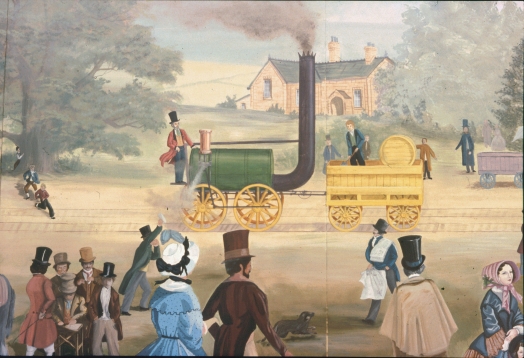Sans Pareil
Resource Type: Image | Posted on 24th October 2011 by Liam Physick
One of the images donated to Metal by Eric Shenton. Here we see the Sans Pareil (without equal), one of the failed entrants in the Rainhill Trials, but one that performed far better than the Cycloped or the Perseverance. It was built by the distinguished engineer Timothy Hackworth, and used a 0-4-0 wheel arrangement. It was allowed to enter the Trials despite being above the weight limit. The judges asked it to run on 7th October, the second day of the Trials, but its boiler was leaking, so Hackworth requested, and was granted, more time. It finally got its chance six days later, and gave an impressive performance, reaching 16 miles an hour, but on its eighth trip broke down due to a problem with the water pump. The pump was repaired, and the engine restarted, only for the pump to fail again soon afterwards, causing the Sans Pareil to be withdrawn from the competition. Despite its impressive performance at the Trials, reaching 16 miles per hour, the Sans Pareil’s vertical, inverted cylinders gave it a bizarre rolling gait, and prevented springs being used to carry the locomotive. More seriously, as was typical with Hackworth’s engines, the blast from the blastpipe was very strong, causing most of the coke to be expelled unburnt from the chimney. Therefore, the locomotive had poor fuel economy. Afterwards, Hackworth discovered a cracked cylinder, which had undermined the engine’s power (manufactured, ironically, by Robert Stephenson and Co, inevitably provoking conspiracy theories), but it was nevertheless bought by the Liverpool and Manchester Railway for £350. Sold in 1831 to John Hargreaves and Son, who then leased it to the Bolton and Leigh Railway, it remained in active service as a locomotive until 1844, unlike the Rocket, which lasted only 10 years. In 1840, the Sans Pareil was sold to the Coppull Colliery, and in 1844 its wheels were removed to convert it into a fixed engine, a role it retained until 1863, when John Hick restored it and added new wheels. It is now kept in the Shildon Locomotive Museum, which also houses a replica of the original, built for the re-enactment of the Rainhill Trials at the Rocket 150 celebrations. In 2009, the replica was cosmetically restored to its original condition, and in 2010 sent to the Nuremberg Transport Museum to celebrate 175th anniversary of Germany’s first steam locomotive run: a 1934 replica of the Rocket was also sent there. British Rail No. 86214, a Class 86 electric locomotive, was named after the Sans Pareil: it was scrapped in 2006
Categorised under: Landmarks, Landscapes & Locomotives

Comments